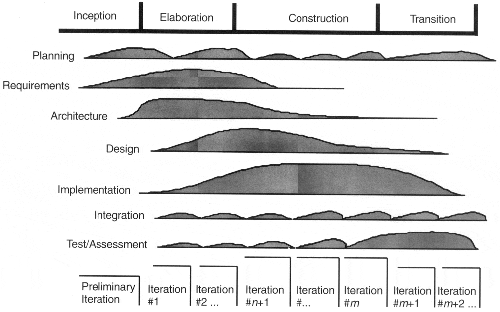A SHIFTING FOCUS ACROSS THE CYCLE
A SHIFTING FOCUS ACROSS THE CYCLE
Remember that each iteration follows a pattern similar to the water-fall approach, and therefore its workflow contains the activities of requirements elicitation and analysis, of design and implementation, and of integration and test. But from one iteration to the next and from one phase to the next , the emphasis on the various activities changes.
Figure 4-7 shows the relative emphasis of the various types of activities over time. If you look at a cross-section of the activities in the middle of each phase, you will notice a number of things:
Figure 4-7. Importance of activities across one development cycle

-
In the inception phase, the focus is on understanding the overall requirements and determining the scope of the development effort.
-
In the elaboration phase, the focus is on requirements, but some software design and implementation is aimed at prototyping the architecture, mitigating certain technical risks by trying solutions, and learning how to use certain tools and techniques. You finally produce an executable architectural prototype that will serve as the baseline [7] for the next phase.
[7] A baseline is a reviewed and approved release of artifacts that constitutes an agreed-on basis for further evolution or development and that can be changed only through a formal procedure, such as change and configuration control.
-
In the construction phase, the focus is on design and implementation. Here, you evolve and flesh out the initial prototype into the first operational product.
-
In the transition phase, the focus is on ensuring that the system has the right level of quality to meet your objectives; you fix bugs , train users, adjust features, and add missing elements. You produce and deliver the final product.
EAN: 2147483647
Pages: 176
- The Four Keys to Lean Six Sigma
- When Companies Start Using Lean Six Sigma
- Making Improvements That Last: An Illustrated Guide to DMAIC and the Lean Six Sigma Toolkit
- The Experience of Making Improvements: What Its Like to Work on Lean Six Sigma Projects
- Six Things Managers Must Do: How to Support Lean Six Sigma